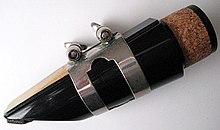Ligature (woodwind instrument)
For woodwind instruments with a simple reed, a fastening unit is called a ligature , or rather a reed holder , with the purpose of fixing the reed on the mouthpiece. The term ligature is used in English and French-speaking countries .
The rolling paper is stored separately between play cycles and positioned on the mouthpiece before each use. The ligature is then used to clamp it securely in place at the predetermined location. In addition, the retention system must not hinder or distort the vibration behavior of the leaflet as the active and variable part of the instrument.
scope of application
In the western world today, these instruments essentially include the entire family of saxophones and clarinets. The size of the corresponding type is determined according to the position of the keynote series within the tone system. A mouthpiece classification is assigned to each size. Its shape is different around the world according to the manufacturer's ideas regarding sound and music genre. The construction of the blade holder has to take this range of variation into account.
history
clarinet
Their forerunners go back to antiquity . The Nuremberg instrument maker Johann Christoph Denner achieved decisive improvements around 1700. An early form of the clarinet mouthpiece was created around 1720, where a cord served as a reed holder. Another leap in the development of the clarinet was made by Iwan Müller. On his concert tours around 1815 in Holland, England and Germany he used an adjustable metal ring as a reed holder. This principle is still used today and has largely supplanted the cord.
saxophone
On March 21, 1846, Adolphe Sax filed a French patent application for a new system of wind instruments called saxophones . The ligature is not specifically mentioned. However, they can be clearly seen in the drawings. Beeckmann, who teaches at the Brussels Conservatory , writes in his school for the baritone saxophone published around 1870: “The reed holder is used to attach the reed to the table; it consists of a metal band, connected by two screws, ... “.
Basic principle in the range of offers
International manufacturers of saxophones and clarinets as well as those of the associated mouthpieces present their products as standard on glossy paper with the conventional ligature. The force acting on the leaflet is difficult to estimate. Contact points between the sheet metal and the back of the leaflet are distributed in an uncontrolled manner and are placed differently when the same leaflet is repeatedly stretched. This fastening means leads to an uneven distribution of pressure between the leaflet and table, can lead to raised (non-contact) areas and permanently deform the shaft of the leaflet. Variations in the sheet metal thickness, one or two screws, different materials, pressure plate with support points, surface coating, etc. convey uncertainty. Ornaments and variations of the basic principle (vinyl tape, hard plastic, etc.) do not form the basis for the paper to function properly.
Current state
For generations, inventors have tried to remedy these inadequacies. One of the first patents to be granted is the "Device for fixing the reed in clarinets", patent specification No. 89067 of February 26, 1896. Since then, innumerable attempts have been made to meet the requirements of sound production and the demands of musicians. The results are not very encouraging. The representation of the relationship between the leaflet and the leaf holder in the specialist literature is contradictory, incomplete or missing completely.
In a new patent specification entitled “Professional Blade Holder”, European patent number EP2111614, clear clamping guidelines are presented for the first time. The pressure system transfers an even contact of the entire contact surface of the leaflet on the mouthpiece table. As a result, an optimal ratio of sheet thickness and web opening can be aimed for. The pressure required for control in the lower register is reduced to a minimum. This promotes easy blowing and reliable classification of the leaflets through repeatable, identical clamping conditions. The prerequisites for a fine tone, especially in the lower register, are given.
See also
Reading list
- The saxophones . Erwin Bochinsky publishing house, Frankfurt am Main 1994, ISBN 3-923639-98-8 .
- Jürgen Bachmann: From body to clay. Chili Notes Musikverlag, Frankfurt am Main 2001, DNB 965452395 .
- Kurt Birsak: The clarinet. Verlag Obermayer, Buchloe 1992, ISBN 3-9800919-8-8 .
- Jack Brymer: The clarinet. Fischer Taschenbuch Verlag, Frankfurt am Main 1983, ISBN 3-596-22986-3 .
- Patent EP2111614 : Professional sheet holder. Published October 28, 2009 .
- Patent DE89067 : Device for fixing the reed in clarinets. Published February 26, 1896 .

